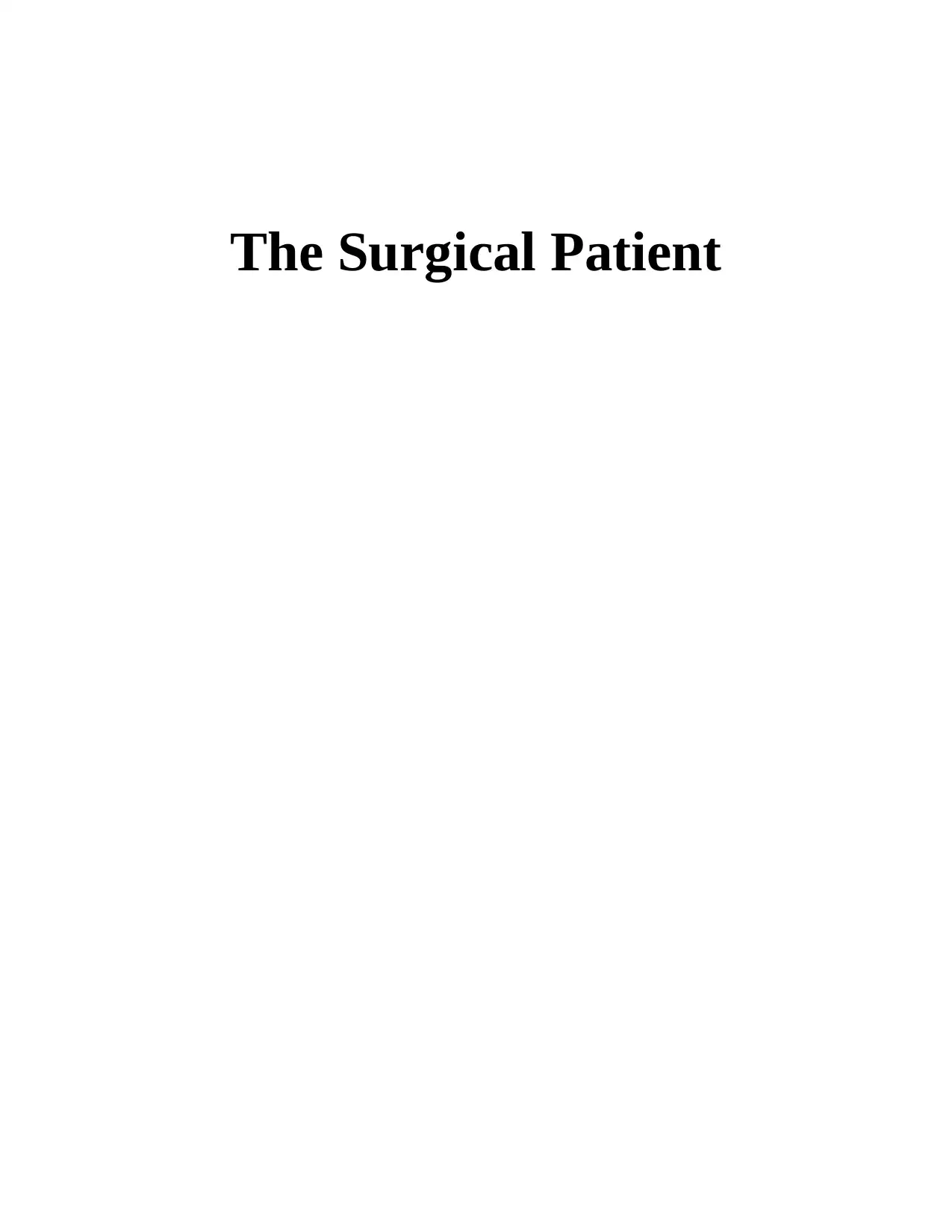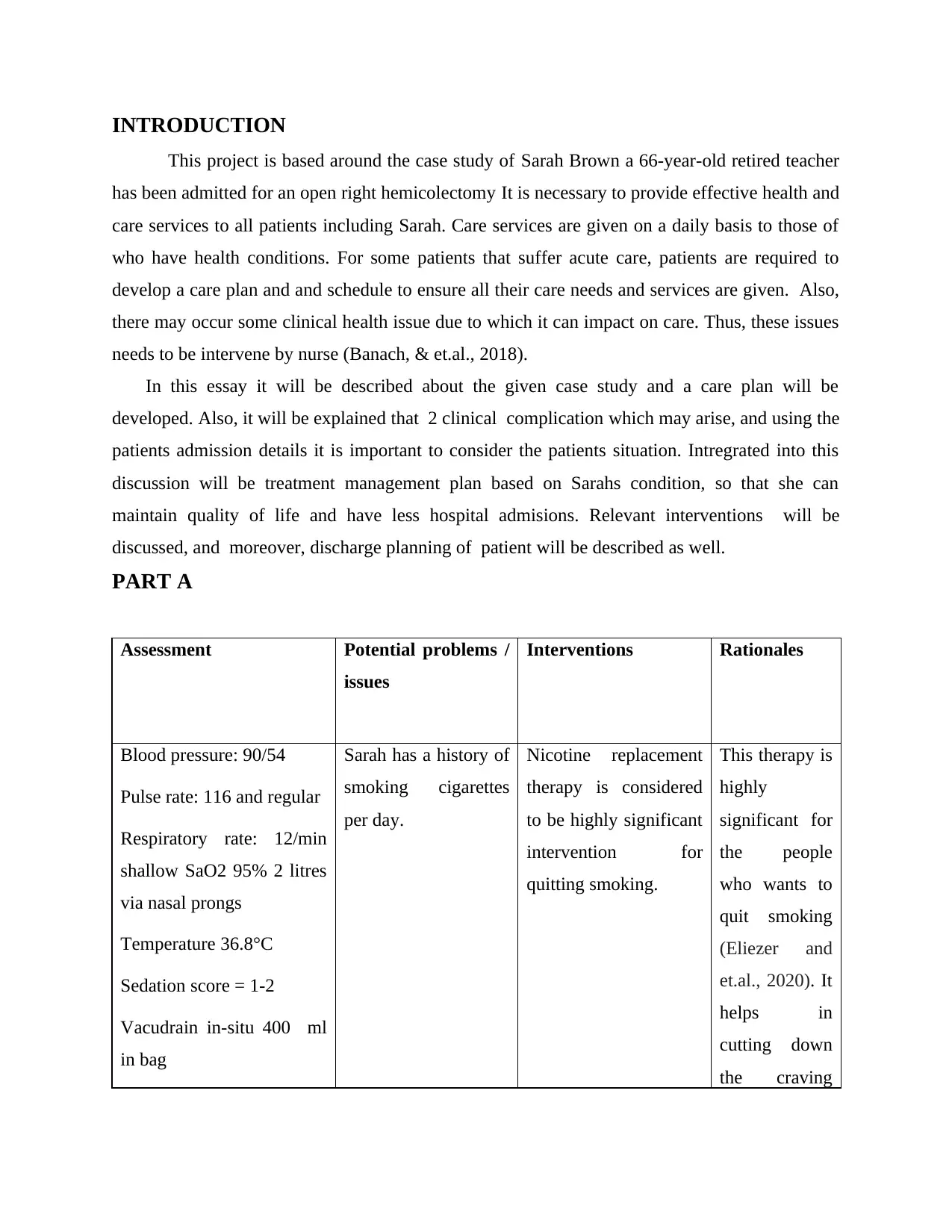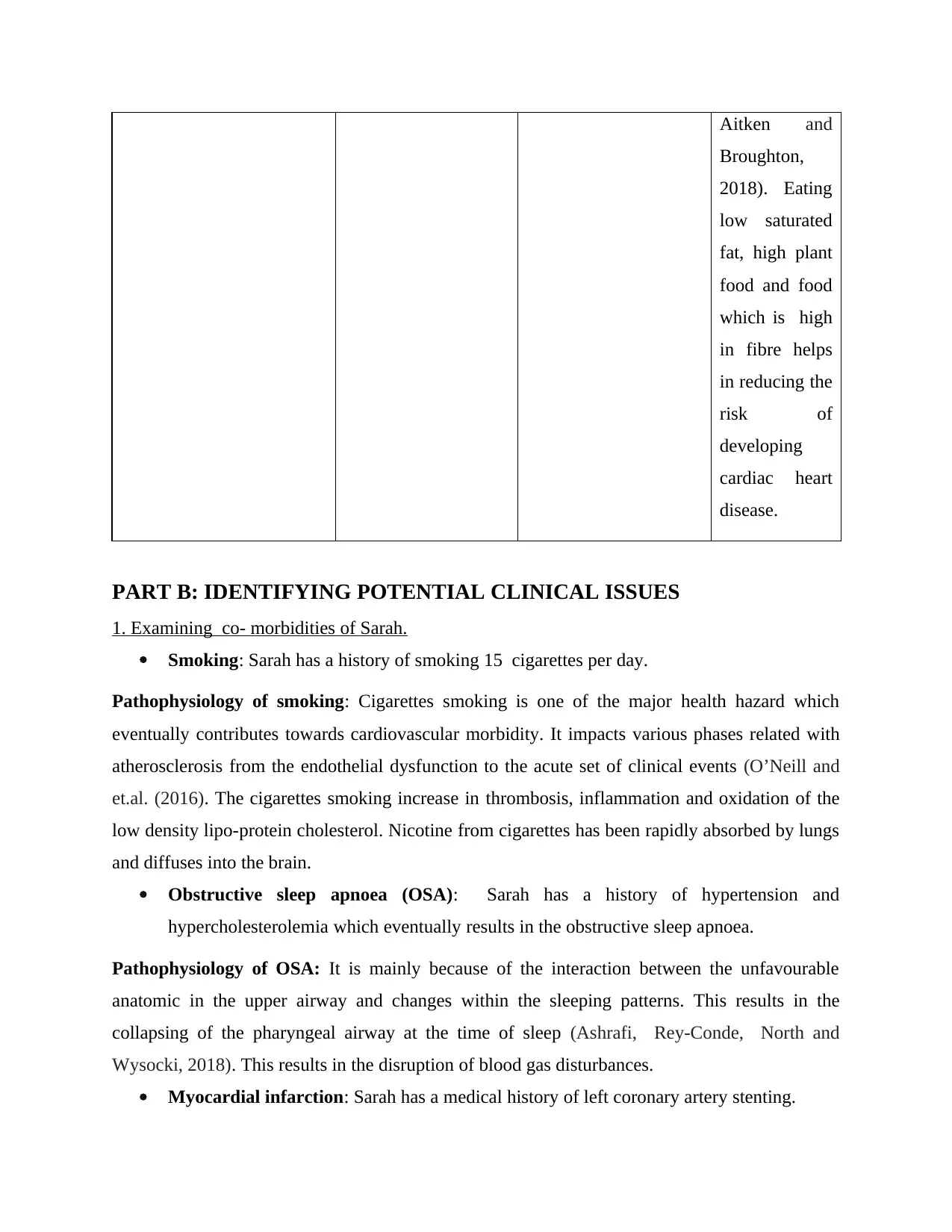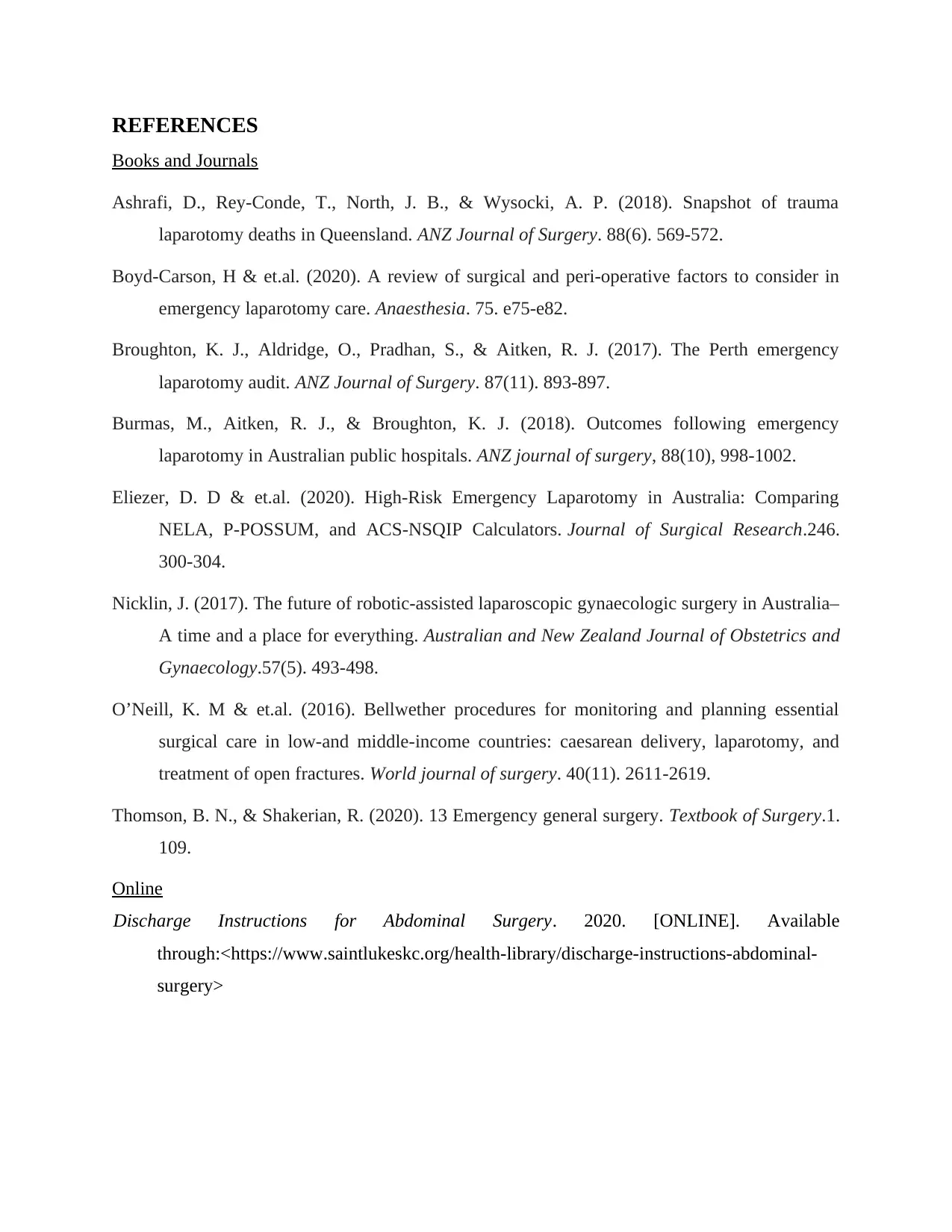Nursing Care Plan for a Surgical Patient: Sarah Brown's Case Study
VerifiedAdded on 2023/01/06
|8
|1880
|46
Report
AI Summary
This report presents a detailed case study analysis of Sarah Brown, a 66-year-old patient admitted for an open right hemicolectomy. The report focuses on developing a comprehensive care plan, considering Sarah's medical history, including smoking, obstructive sleep apnea, and myocardial infarction. It identifies potential clinical issues, such as postoperative ileus and abdominal pain, and evaluates appropriate nursing interventions, providing rationales for each. Furthermore, the report prioritizes a discharge advice plan, emphasizing vital sign monitoring, medication adherence, dietary considerations, breathing exercises, and incision care. The analysis incorporates relevant literature and aims to provide effective health and care services, ensuring a quality of life with fewer hospital readmissions. The report underscores the importance of proactive planning and intervention to prevent clinical deterioration and improve patient outcomes.

The Surgical Patient
Paraphrase This Document
Need a fresh take? Get an instant paraphrase of this document with our AI Paraphraser

Table of Contents
INTRODUCTION...........................................................................................................................3
PART A...........................................................................................................................................3
PART B: IDENTIFYING POTENTIAL CLINICAL ISSUES.......................................................5
1. Examining co- morbidities of Sarah......................................................................................5
2. Evaluating 2 potential clinical complications associated with co- morbidities which may
arise within a period of 24 hours.................................................................................................6
3. Evaluating the nursing intervention with significant rationale...............................................6
PART C............................................................................................................................................7
Prioritizing discharge advice plan...............................................................................................7
CONCLUSION................................................................................................................................7
REFERENCES................................................................................................................................9
INTRODUCTION...........................................................................................................................3
PART A...........................................................................................................................................3
PART B: IDENTIFYING POTENTIAL CLINICAL ISSUES.......................................................5
1. Examining co- morbidities of Sarah......................................................................................5
2. Evaluating 2 potential clinical complications associated with co- morbidities which may
arise within a period of 24 hours.................................................................................................6
3. Evaluating the nursing intervention with significant rationale...............................................6
PART C............................................................................................................................................7
Prioritizing discharge advice plan...............................................................................................7
CONCLUSION................................................................................................................................7
REFERENCES................................................................................................................................9

INTRODUCTION
This project is based around the case study of Sarah Brown a 66-year-old retired teacher
has been admitted for an open right hemicolectomy It is necessary to provide effective health and
care services to all patients including Sarah. Care services are given on a daily basis to those of
who have health conditions. For some patients that suffer acute care, patients are required to
develop a care plan and and schedule to ensure all their care needs and services are given. Also,
there may occur some clinical health issue due to which it can impact on care. Thus, these issues
needs to be intervene by nurse (Banach, & et.al., 2018).
In this essay it will be described about the given case study and a care plan will be
developed. Also, it will be explained that 2 clinical complication which may arise, and using the
patients admission details it is important to consider the patients situation. Intregrated into this
discussion will be treatment management plan based on Sarahs condition, so that she can
maintain quality of life and have less hospital admisions. Relevant interventions will be
discussed, and moreover, discharge planning of patient will be described as well.
PART A
Assessment Potential problems /
issues
Interventions Rationales
Blood pressure: 90/54
Pulse rate: 116 and regular
Respiratory rate: 12/min
shallow SaO2 95% 2 litres
via nasal prongs
Temperature 36.8°C
Sedation score = 1-2
Vacudrain in-situ 400 ml
in bag
Sarah has a history of
smoking cigarettes
per day.
Nicotine replacement
therapy is considered
to be highly significant
intervention for
quitting smoking.
This therapy is
highly
significant for
the people
who wants to
quit smoking
(Eliezer and
et.al., 2020). It
helps in
cutting down
the craving
This project is based around the case study of Sarah Brown a 66-year-old retired teacher
has been admitted for an open right hemicolectomy It is necessary to provide effective health and
care services to all patients including Sarah. Care services are given on a daily basis to those of
who have health conditions. For some patients that suffer acute care, patients are required to
develop a care plan and and schedule to ensure all their care needs and services are given. Also,
there may occur some clinical health issue due to which it can impact on care. Thus, these issues
needs to be intervene by nurse (Banach, & et.al., 2018).
In this essay it will be described about the given case study and a care plan will be
developed. Also, it will be explained that 2 clinical complication which may arise, and using the
patients admission details it is important to consider the patients situation. Intregrated into this
discussion will be treatment management plan based on Sarahs condition, so that she can
maintain quality of life and have less hospital admisions. Relevant interventions will be
discussed, and moreover, discharge planning of patient will be described as well.
PART A
Assessment Potential problems /
issues
Interventions Rationales
Blood pressure: 90/54
Pulse rate: 116 and regular
Respiratory rate: 12/min
shallow SaO2 95% 2 litres
via nasal prongs
Temperature 36.8°C
Sedation score = 1-2
Vacudrain in-situ 400 ml
in bag
Sarah has a history of
smoking cigarettes
per day.
Nicotine replacement
therapy is considered
to be highly significant
intervention for
quitting smoking.
This therapy is
highly
significant for
the people
who wants to
quit smoking
(Eliezer and
et.al., 2020). It
helps in
cutting down
the craving
⊘ This is a preview!⊘
Do you want full access?
Subscribe today to unlock all pages.

Trusted by 1+ million students worldwide

Urine output via a Foley
IDC: 15-20 mls/hour
Pain score 6 on a scale of
0-10
related with
nicotine.
Risk of severe pain Use of the over the
counter medication is
useful in the reduction
of pain, swelling and
inflammation after the
surgery (Broughton,
Aldridge, Pradhan, and
Aitken, 2017).
Use of the
over the
counter pain
medication
helps in
reducing pain
after the
surgery.
Obstructive sleep
apnoea
The patient must focus
on encouraging deep
breathing practice
every hour.
It is significant
in promoting
expansion of
the normal
lung and also
increases the
level if oxygen
(Nicklin,
2017).
Cardiac heart disease The patient must focus
on managing stress, eat
healthy and do regular
exercise (Thomson and
Shakerian, (2020). The
patient must quit
smoking and control
blood pressure and
cholesterol levels.
Regular
exercise helps
in making the
heart muscle
even stronger.
It is useful in
lowering of
the cholesterol
level and
blood pressure
(Burmas,
IDC: 15-20 mls/hour
Pain score 6 on a scale of
0-10
related with
nicotine.
Risk of severe pain Use of the over the
counter medication is
useful in the reduction
of pain, swelling and
inflammation after the
surgery (Broughton,
Aldridge, Pradhan, and
Aitken, 2017).
Use of the
over the
counter pain
medication
helps in
reducing pain
after the
surgery.
Obstructive sleep
apnoea
The patient must focus
on encouraging deep
breathing practice
every hour.
It is significant
in promoting
expansion of
the normal
lung and also
increases the
level if oxygen
(Nicklin,
2017).
Cardiac heart disease The patient must focus
on managing stress, eat
healthy and do regular
exercise (Thomson and
Shakerian, (2020). The
patient must quit
smoking and control
blood pressure and
cholesterol levels.
Regular
exercise helps
in making the
heart muscle
even stronger.
It is useful in
lowering of
the cholesterol
level and
blood pressure
(Burmas,
Paraphrase This Document
Need a fresh take? Get an instant paraphrase of this document with our AI Paraphraser

Aitken and
Broughton,
2018). Eating
low saturated
fat, high plant
food and food
which is high
in fibre helps
in reducing the
risk of
developing
cardiac heart
disease.
PART B: IDENTIFYING POTENTIAL CLINICAL ISSUES
1. Examining co- morbidities of Sarah.
Smoking: Sarah has a history of smoking 15 cigarettes per day.
Pathophysiology of smoking: Cigarettes smoking is one of the major health hazard which
eventually contributes towards cardiovascular morbidity. It impacts various phases related with
atherosclerosis from the endothelial dysfunction to the acute set of clinical events (O’Neill and
et.al. (2016). The cigarettes smoking increase in thrombosis, inflammation and oxidation of the
low density lipo-protein cholesterol. Nicotine from cigarettes has been rapidly absorbed by lungs
and diffuses into the brain.
Obstructive sleep apnoea (OSA): Sarah has a history of hypertension and
hypercholesterolemia which eventually results in the obstructive sleep apnoea.
Pathophysiology of OSA: It is mainly because of the interaction between the unfavourable
anatomic in the upper airway and changes within the sleeping patterns. This results in the
collapsing of the pharyngeal airway at the time of sleep (Ashrafi, Rey‐Conde, North and
Wysocki, 2018). This results in the disruption of blood gas disturbances.
Myocardial infarction: Sarah has a medical history of left coronary artery stenting.
Broughton,
2018). Eating
low saturated
fat, high plant
food and food
which is high
in fibre helps
in reducing the
risk of
developing
cardiac heart
disease.
PART B: IDENTIFYING POTENTIAL CLINICAL ISSUES
1. Examining co- morbidities of Sarah.
Smoking: Sarah has a history of smoking 15 cigarettes per day.
Pathophysiology of smoking: Cigarettes smoking is one of the major health hazard which
eventually contributes towards cardiovascular morbidity. It impacts various phases related with
atherosclerosis from the endothelial dysfunction to the acute set of clinical events (O’Neill and
et.al. (2016). The cigarettes smoking increase in thrombosis, inflammation and oxidation of the
low density lipo-protein cholesterol. Nicotine from cigarettes has been rapidly absorbed by lungs
and diffuses into the brain.
Obstructive sleep apnoea (OSA): Sarah has a history of hypertension and
hypercholesterolemia which eventually results in the obstructive sleep apnoea.
Pathophysiology of OSA: It is mainly because of the interaction between the unfavourable
anatomic in the upper airway and changes within the sleeping patterns. This results in the
collapsing of the pharyngeal airway at the time of sleep (Ashrafi, Rey‐Conde, North and
Wysocki, 2018). This results in the disruption of blood gas disturbances.
Myocardial infarction: Sarah has a medical history of left coronary artery stenting.

Pathophysiology of Myocardial infarction: It is referred to as the irreversible damage to the
myocardial tissue which has been caused by the hypertension and Hypercholesterolemia (Boyd‐
Carson and et.al. 2020). It results in the formation of the blood clot.
The current medications which has been given associated with the postoperative clinical data
are:
Simvastatin 40mg nocte
Captopril 150 mg/day
Ranitidine 150mg BD
Aspirin 100 mg mane
Morphine PCA 1mg bolus: 5 minute lockout
Regular paracetamol 1G QID (PO/IV)
Oxygen 2L via nasal prongs
Intravenous infusion: Sodium Chloride 0.9% (Normal Saline) (NaCl) 100mls/hour
IV Cefoxitin 2gms.
2. Evaluating 2 potential clinical complications associated with co- morbidities which may arise
within a period of 24 hours.
Postoperative ileus: This is one of the key common clinical complication which in turn tends to
arise after the abdominal surgery. It happens mainly because of the stoppage within the intestinal
movements for the specific period.
Abdominal pain: One of the key clinical complication linked with the laparotomy is the pain
within the abdominal area. This is mainly caused because of the adhesions.
3. Evaluating the nursing intervention with significant rationale.
Postoperative ileus
Intervention: The nurses must focus on minimizing the intestinal trauma at the time of surgery
(Burmas, Aitken and Broughton, 2018). Use of the non- steroidal anti- inflammatory drug
therapy helps in improving the postoperative ileus by effectively reducing the amount of the
opiods by 20- 30%.
Rationale: It helps in minimizing the use of opioids for the management of pain. This way it
helps in reducing the risk of postoperative ileus.
Abdominal pain
Intervention: Acute pain management is one of the key prominent intervention because it helps
in managing the pain after the surgery. Use of analgesia medication is significant in reliving the
pain after the surgery.
myocardial tissue which has been caused by the hypertension and Hypercholesterolemia (Boyd‐
Carson and et.al. 2020). It results in the formation of the blood clot.
The current medications which has been given associated with the postoperative clinical data
are:
Simvastatin 40mg nocte
Captopril 150 mg/day
Ranitidine 150mg BD
Aspirin 100 mg mane
Morphine PCA 1mg bolus: 5 minute lockout
Regular paracetamol 1G QID (PO/IV)
Oxygen 2L via nasal prongs
Intravenous infusion: Sodium Chloride 0.9% (Normal Saline) (NaCl) 100mls/hour
IV Cefoxitin 2gms.
2. Evaluating 2 potential clinical complications associated with co- morbidities which may arise
within a period of 24 hours.
Postoperative ileus: This is one of the key common clinical complication which in turn tends to
arise after the abdominal surgery. It happens mainly because of the stoppage within the intestinal
movements for the specific period.
Abdominal pain: One of the key clinical complication linked with the laparotomy is the pain
within the abdominal area. This is mainly caused because of the adhesions.
3. Evaluating the nursing intervention with significant rationale.
Postoperative ileus
Intervention: The nurses must focus on minimizing the intestinal trauma at the time of surgery
(Burmas, Aitken and Broughton, 2018). Use of the non- steroidal anti- inflammatory drug
therapy helps in improving the postoperative ileus by effectively reducing the amount of the
opiods by 20- 30%.
Rationale: It helps in minimizing the use of opioids for the management of pain. This way it
helps in reducing the risk of postoperative ileus.
Abdominal pain
Intervention: Acute pain management is one of the key prominent intervention because it helps
in managing the pain after the surgery. Use of analgesia medication is significant in reliving the
pain after the surgery.
⊘ This is a preview!⊘
Do you want full access?
Subscribe today to unlock all pages.

Trusted by 1+ million students worldwide

Rationale: This clinical complication requires immediate set of management. It is very crucial to
manage the post- operative pain after the surgery (Ashrafi, Rey‐Conde, North and Wysocki,
2018). It is of key relevance importance for the management of the pain because it leads to
further complications like shallow breathing, retention of secretions, etc.
PART C
Prioritizing discharge advice plan.
The nurse will effectively evaluate the key vital signs of the Sarah before discharging.
The patient in turn has been asked to take proper rest ask the family members and friends to help
the patient with other chores and errands (Discharge Instructions for Abdominal Surgery, 2020).
The patient is not allowed to lift up anything which weighs over 10 pounds post 4 to 6 weeks of
the surgery. The patient is required to undergo the prescribed set of medication by the health care
practitioner. The patient is also required to effectively comply with the dietary plan. Intake of
more and more liquids is of key significance importance. The patient must carry out the
breathing exercise. This way it helps in the avoidance of lung infection. It is of key relevance
importance to keep the incision clean. Sarah has the history of occasional diarrhoea and in case it
last for more than 3 days then immediately call the health care provider (Broughton, Aldridge,
Pradhan, and Aitken, 2017). Regular check up is of key relevance importance and carrying out
proper test is of utmost importance.
CONCLUSION
It can be summarized from essay that acute care requires a proper planning. Sarah is having
a medical history of hypertension, OSA, and MI. so, she can also suffer from co morbidity of
general anaesthetic in 24 hours. Due to it she can loss her unconsciousness and memory.
Furthermore, there are 2 clinical complication which can occur as it is related to her co morbidity
that is lung failure and heart disease. Also, there are certain intervention which can be taken to
prevent clinical deterioration that is collecting data, recording vital signs. A discharge plan is
developed to give advice to Sarah and family members.
manage the post- operative pain after the surgery (Ashrafi, Rey‐Conde, North and Wysocki,
2018). It is of key relevance importance for the management of the pain because it leads to
further complications like shallow breathing, retention of secretions, etc.
PART C
Prioritizing discharge advice plan.
The nurse will effectively evaluate the key vital signs of the Sarah before discharging.
The patient in turn has been asked to take proper rest ask the family members and friends to help
the patient with other chores and errands (Discharge Instructions for Abdominal Surgery, 2020).
The patient is not allowed to lift up anything which weighs over 10 pounds post 4 to 6 weeks of
the surgery. The patient is required to undergo the prescribed set of medication by the health care
practitioner. The patient is also required to effectively comply with the dietary plan. Intake of
more and more liquids is of key significance importance. The patient must carry out the
breathing exercise. This way it helps in the avoidance of lung infection. It is of key relevance
importance to keep the incision clean. Sarah has the history of occasional diarrhoea and in case it
last for more than 3 days then immediately call the health care provider (Broughton, Aldridge,
Pradhan, and Aitken, 2017). Regular check up is of key relevance importance and carrying out
proper test is of utmost importance.
CONCLUSION
It can be summarized from essay that acute care requires a proper planning. Sarah is having
a medical history of hypertension, OSA, and MI. so, she can also suffer from co morbidity of
general anaesthetic in 24 hours. Due to it she can loss her unconsciousness and memory.
Furthermore, there are 2 clinical complication which can occur as it is related to her co morbidity
that is lung failure and heart disease. Also, there are certain intervention which can be taken to
prevent clinical deterioration that is collecting data, recording vital signs. A discharge plan is
developed to give advice to Sarah and family members.
Paraphrase This Document
Need a fresh take? Get an instant paraphrase of this document with our AI Paraphraser

REFERENCES
Books and Journals
Ashrafi, D., Rey‐Conde, T., North, J. B., & Wysocki, A. P. (2018). Snapshot of trauma
laparotomy deaths in Queensland. ANZ Journal of Surgery. 88(6). 569-572.
Boyd‐Carson, H & et.al. (2020). A review of surgical and peri‐operative factors to consider in
emergency laparotomy care. Anaesthesia. 75. e75-e82.
Broughton, K. J., Aldridge, O., Pradhan, S., & Aitken, R. J. (2017). The Perth emergency
laparotomy audit. ANZ Journal of Surgery. 87(11). 893-897.
Burmas, M., Aitken, R. J., & Broughton, K. J. (2018). Outcomes following emergency
laparotomy in Australian public hospitals. ANZ journal of surgery, 88(10), 998-1002.
Eliezer, D. D & et.al. (2020). High-Risk Emergency Laparotomy in Australia: Comparing
NELA, P-POSSUM, and ACS-NSQIP Calculators. Journal of Surgical Research.246.
300-304.
Nicklin, J. (2017). The future of robotic‐assisted laparoscopic gynaecologic surgery in Australia–
A time and a place for everything. Australian and New Zealand Journal of Obstetrics and
Gynaecology.57(5). 493-498.
O’Neill, K. M & et.al. (2016). Bellwether procedures for monitoring and planning essential
surgical care in low-and middle-income countries: caesarean delivery, laparotomy, and
treatment of open fractures. World journal of surgery. 40(11). 2611-2619.
Thomson, B. N., & Shakerian, R. (2020). 13 Emergency general surgery. Textbook of Surgery.1.
109.
Online
Discharge Instructions for Abdominal Surgery. 2020. [ONLINE]. Available
through:<https://www.saintlukeskc.org/health-library/discharge-instructions-abdominal-
surgery>
Books and Journals
Ashrafi, D., Rey‐Conde, T., North, J. B., & Wysocki, A. P. (2018). Snapshot of trauma
laparotomy deaths in Queensland. ANZ Journal of Surgery. 88(6). 569-572.
Boyd‐Carson, H & et.al. (2020). A review of surgical and peri‐operative factors to consider in
emergency laparotomy care. Anaesthesia. 75. e75-e82.
Broughton, K. J., Aldridge, O., Pradhan, S., & Aitken, R. J. (2017). The Perth emergency
laparotomy audit. ANZ Journal of Surgery. 87(11). 893-897.
Burmas, M., Aitken, R. J., & Broughton, K. J. (2018). Outcomes following emergency
laparotomy in Australian public hospitals. ANZ journal of surgery, 88(10), 998-1002.
Eliezer, D. D & et.al. (2020). High-Risk Emergency Laparotomy in Australia: Comparing
NELA, P-POSSUM, and ACS-NSQIP Calculators. Journal of Surgical Research.246.
300-304.
Nicklin, J. (2017). The future of robotic‐assisted laparoscopic gynaecologic surgery in Australia–
A time and a place for everything. Australian and New Zealand Journal of Obstetrics and
Gynaecology.57(5). 493-498.
O’Neill, K. M & et.al. (2016). Bellwether procedures for monitoring and planning essential
surgical care in low-and middle-income countries: caesarean delivery, laparotomy, and
treatment of open fractures. World journal of surgery. 40(11). 2611-2619.
Thomson, B. N., & Shakerian, R. (2020). 13 Emergency general surgery. Textbook of Surgery.1.
109.
Online
Discharge Instructions for Abdominal Surgery. 2020. [ONLINE]. Available
through:<https://www.saintlukeskc.org/health-library/discharge-instructions-abdominal-
surgery>
1 out of 8
Related Documents
Your All-in-One AI-Powered Toolkit for Academic Success.
+13062052269
info@desklib.com
Available 24*7 on WhatsApp / Email
![[object Object]](/_next/static/media/star-bottom.7253800d.svg)
Unlock your academic potential
Copyright © 2020–2026 A2Z Services. All Rights Reserved. Developed and managed by ZUCOL.





